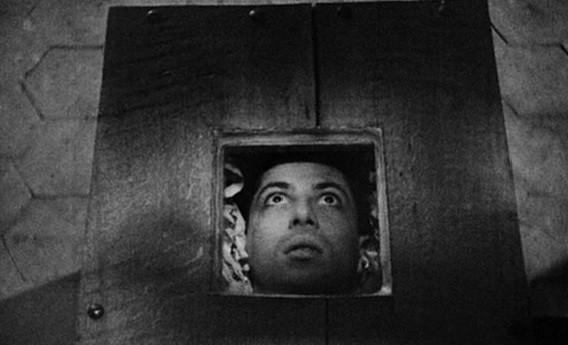Long-haired Asian ghost hags and jump scares are old, tired, worn out, right? Right! Which is why Coming Soon is at times embarrassing to watch; it's doing the same old tricks, tricks that kids are doing on their own youtube videos these days. If a film can't outdo a twelve-year-old's youtube video, it's got big problems.
Coming Soon has an utterly predictable story. The first five minutes are so free of subtlety I had guessed the "shocking" twist right there at the beginning. It was just a matter of waiting for its main characters to figure out. Chen, the protagonist, is a cinema employee getting into the bootlegging industry. It just so happens the one film he chooses is haunted by the ghost of the film's eye-plucking hag villain. Whoever sees a certain scene in the film ends up dead and inside the movie.
The film plays out exactly as you might expect, with Chen and his girlfriend launching an investigation, eventually finding the truth, and then realizing they must stop the film from being distributed before it's too late. There are some inventive moments in the last twenty minutes, involving a deja vu scene of sorts. I was fairly impressed and entertained by that, but it's too little too late.
While I wouldn't dare give the film credit for having a theme, because it doesn't, it unwittingly explores an issue that's very fascinating to me. That's the difference between watching theatrical gore and violence and watching real gore and violence (which some people on this board do). I don't believe there is any relationship between these activities, other than that some horror fans are confused into thinking there is. Theatrical gore is a game you play with the filmmaker: 'try your best to horrify me.' Real gore is making a spectacle of someone really being hurt and/or killed.
Unless you can't get enough of Asian oh-so-creepy ghost women jumpcutting right in front of the camera with a sudden loud noise on the soundtrack, miss Coming Soon. It is a decent idea that was in need of a good screenplay to make it work and it didn't get it.
Help make this site more interesting through discussion:
Coming Soon (2008) - 1/4
Author: Jared RobertsThe Black Cat (1968)
Author: Jared RobertsThe Black Cat is a love story. A vampire story. A ghost story. A samurai story. A family drama. A tragedy. A morality tale. It is emotionally and psychologically complex, but narrativistically simple.
A beautiful young woman and her mother-in-law are raped and murdered by a group of samurai. They sell their souls to 'the evil gods' in exchange for revenge: eternal blood-thirst for all samurai. The husband of the young woman got lucky and killed an enemy general, earning him instant promotion to samurai. The myriad conflicts that ensues you'll have to watch to see.
Japanese horror of the '60s had a fixation on several elements that are instantly recognizable: 1. Samurai. 2. Morality tales. 3. Raped women. 4. Vengeful, life-sucking ghosts. 5. Exquisite cinematography. I've only seen three myself, Kwaidan, Ugetsu (which isn't quite a horror film), and The Black Cat. While Kwaidan is the most beautiful visually, it achieves this with glacial pace. You wouldn't think short, anthologized stories could move so slowly. Ugetsu has the greatest story and the strongest impact with its morally complex vision. But The Black Cat is the best out and out horror film with the superior kinetics.
The Black Cat can only be described as choreographed. It's like a ballet with the celluloid as the stage. Every element of movement is controlled: the women somersaulting through the air, the fog in the wind, the samurai's blade. Disorienting jump-cuts accompany the highly mobile evil spirits whenever they're fighting, giving them a much more vital feel than the actually living people. Their vitality is their hatred. Where emotions like greed or ambition are self-serving, love and hate are purely other-directed. They expend all one's energy. In The Black Cat they are pitted against one another.
This is a gorgeous example of the fine era of Japanese fantastique cinema, to be watched alongside Onibaba, Woman in the Dunes, Kwaidan and even Ugetsu as an equal.

